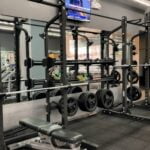Are you looking to improve your soccer performance? If so, you’ve come to the right place to learn how to get soccer fit exercises. Being fit is essential for soccer players as it can greatly impact their performance on the field. From endurance and stamina to speed and agility, being in top physical shape is crucial for excelling in this sport.
In this article, we will explore the various exercises and training techniques that can help you get soccer fit. We’ll cover everything from warm-up exercises to cardiovascular training, strength training, core stability, speed and agility drills, flexibility and mobility exercises, as well as recovery and rest strategies. By incorporating these exercises into your training regimen, you’ll be on your way to improving your overall fitness and performance on the soccer field.
Whether you’re a seasoned player or just starting out, understanding the importance of being fit for soccer and knowing how to enhance your physical condition will give you an edge over your opponents. So let’s dive in and discover how these exercises can help elevate your game and take your performance to the next level.
Warm-Up Exercises
Jogging is another important component of a soccer warm-up. It helps raise the heart rate gradually, allowing the body to transition from a resting state to one that is ready for physical exertion. Additionally, jogging helps improve circulation and warms up the muscles, making them more pliable during subsequent exercises.
Agility drills are crucial for improving coordination and reaction time. They involve quick changes in direction, speed, and footwork, replicating the movements commonly seen on a soccer field. These drills can include ladder drills, cone drills, and shuttle runs, all of which help players become more agile and responsive during gameplay.
| Exercise | Description |
|---|---|
| Dynamic Stretching | Improves flexibility and reduces the risk of injury by incorporating movements such as leg swings, arm circles, and hip rotations. |
| Jogging | Gradually raises heart rate, improves circulation, warms up muscles. |
Cardiovascular Training
Benefits of Cardiovascular Training
Cardiovascular training is an essential component of soccer fitness, as it helps improve endurance and stamina on the field. Running, interval training, and shuttle runs are all effective methods for enhancing cardiovascular fitness. By engaging in these types of exercises, soccer players can increase their lung capacity, improve their heart health, and enhance their overall ability to sustain physical activity for extended periods of time during a game.
Running for Endurance
Long-distance running is a classic method for building endurance and stamina. When incorporating running into their training regimen, soccer players can choose between steady-state runs or more challenging options such as hill sprints or incline intervals. These activities not only improve aerobic capacity but also help players adapt to running at various intensities, mimicking the demands of a soccer match.
Interval Training and Shuttle Runs
Interval training involves alternating between high-intensity bursts of activity and lower-intensity recovery periods. This type of workout is especially beneficial for soccer players, as it mirrors the stop-and-go nature of the sport. Shuttle runs are another effective way to enhance cardiovascular fitness while also improving agility and speed.
By setting up cones at varying distances, players can practice quick changes in direction and acceleration, mimicking the movements commonly performed on the soccer field. Incorporating interval training and shuttle runs into a training program can lead to notable improvements in both endurance and game performance for soccer players.
Strength Training
Squats are a key exercise for strengthening the lower body, including the quadriceps, hamstrings, and glutes. This exercise helps improve stability and explosiveness, which are crucial for movements like jumping and sprinting during a game. Lunges are another effective exercise for targeting the lower body muscles while also working on balance and coordination.
In addition to traditional strength exercises, plyometric drills are great for soccer players as they focus on quick, powerful movements that mimic those seen in the sport. These exercises help enhance explosive power, speed, and agility. Incorporating these exercises into a regular workout routine can significantly benefit soccer players in terms of overall performance on the field.
| Exercise | Benefits |
|---|---|
| Squats | Strengthens quadriceps, hamstrings, and glutes; improves stability and explosiveness |
| Lunges | Targets lower body muscles; works on balance and coordination |
| Plyometric Drills | Enhances explosive power, speed, and agility through quick, powerful movements |
Core Stability
The Role of Core Stability in Soccer
The core muscles, including the abdominals, obliques, and lower back muscles, are essential for maintaining posture and providing a solid foundation for all movement. In soccer, players constantly engage their core muscles to generate power for explosive movements like sprinting and jumping while also maintaining stability during changes in direction.
Exercises for Building Core Strength and Stability
Incorporating core-strengthening exercises into a soccer fitness regimen is essential for improving performance on the field. Some effective exercises include planks, Russian twists, bicycle crunches, and supermans. These exercises target the entire core region and help build strength and stability to support efficient movement during soccer-specific actions.
Additionally, incorporating stability training tools such as Swiss balls or balance boards can further challenge the core muscles while simulating the unpredictable nature of movements experienced on the soccer field. By consistently integrating these exercises into training sessions, soccer players can enhance their overall performance by developing a solid foundation of core strength and stability.
Speed and Agility Drills
Speed and agility are essential components of soccer fitness, as they can greatly impact a player’s performance on the field. Incorporating specific drills into training sessions can help improve these key attributes, leading to better acceleration, change of direction, and overall agility during matches. Here are some effective drills for enhancing speed and agility in soccer:
- Ladder Drills: Ladder drills are excellent for improving footwork, quickness, and coordination. These drills involve a series of footwork patterns performed within the spaces of a ladder laid out on the ground. Exercises like 1-2 step, lateral shuffles, and high knees can all be done using the ladder to enhance speed and agility.
- Cone Drills: Setting up cones in various patterns allows players to practice sharp turns, quick cuts, and rapid changes of direction. Players can perform exercises like T-drills, 5-10-5 shuttle runs, or figure-eight sprints around cones to simulate real-game scenarios that require fast and agile movements.
- Shuttle Sprints: Shuttle sprints involve short bursts of high-intensity running back and forth between set distances. This type of drill helps improve acceleration, deceleration, and explosiveness-crucial elements for soccer players when changing directions or making quick sprints across the field.
By incorporating these speed and agility drills into regular training sessions, soccer players can enhance their overall athleticism and performance on the field. Proper technique execution along with consistency is key to achieving noticeable improvements in speed and agility over time for better game-day results.
Flexibility and Mobility
One important area for soccer players to focus on when it comes to flexibility is the lower body. Stretching exercises such as hamstring stretches, quadriceps stretches, and calf stretches can help improve range of motion and reduce the risk of muscle strains during play.
Additionally, hip flexor stretches and groin stretches can aid in improving agility and quick movements on the field. It is important for players to include these stretches in their warm-up routine before practice or a game, as well as after their training sessions to maintain flexibility.
In addition to lower body flexibility, soccer players should also prioritize stretching exercises for the upper body. Proper shoulder, chest, and back stretches can help improve posture and reduce muscle tension that may inhibit movement during play. A flexible upper body can also contribute to better ball control and overall performance on the field. Overall, incorporating a variety of stretching exercises targeting both upper and lower body areas is essential for improved mobility for soccer players.
Recovery and Rest
As much as training and exercise are crucial for soccer performance, rest and recovery are just as important. Proper rest allows the body to repair and rebuild muscle tissues, while recovery strategies help reduce the risk of injury and improve overall performance on the field. Here are some tips for soccer players to ensure they are prioritizing their rest and recovery:
- Get an adequate amount of sleep each night – aim for 7-9 hours of quality sleep to allow your body to recover.
- Incorporate active recovery activities such as light jogging, swimming, or yoga on rest days to keep the body moving without putting too much strain on muscles.
- Hydrate properly before, during, and after training sessions or matches to support muscle function and overall recovery.
It’s also essential for soccer players to listen to their bodies when it comes to rest and recovery. Overtraining can lead to fatigue, burnout, and a higher risk of injury, so it’s crucial to take scheduled breaks from intense training sessions. Finally, incorporating proper nutrition into your recovery plan is vital – consuming a balance of protein, carbohydrates, healthy fats, vitamins, and minerals can help support muscle repair and replenish energy stores.
Conclusion
In conclusion, it is evident that being soccer fit requires a comprehensive training regimen that includes various types of exercises. From warm-up exercises to cardiovascular training, strength training, core stability, speed and agility drills, flexibility and mobility work, to prioritizing recovery and rest, each aspect contributes to the overall fitness and performance of a soccer player. Incorporating these exercises into a regular training routine can lead to improved endurance, strength, speed, agility, and flexibility on the field.
By engaging in dynamic warm-up exercises and cardiovascular training, soccer players can enhance their overall endurance and stamina. Furthermore, integrating strength training and core stability exercises not only helps prevent injuries but also improves muscular strength crucial for soccer performance. Speed and agility drills are essential for quick movements and responsive actions during game play.
Additionally, prioritizing flexibility work ensures improved mobility on the field. Finally, proper recovery and rest are equally important in allowing the body to recuperate from intense workouts. In essence, by dedicating time to each of these exercise categories within a soccer training regimen, players can achieve overall fitness that translates into improved performance during matches.
Frequently Asked Questions
How Do You Train to Be Fit for Soccer?
To train to be fit for soccer, it’s important to focus on both cardiovascular fitness and strength training. Cardiovascular exercises like running, interval sprints, and high-intensity interval training can help improve endurance and stamina on the field.
Additionally, incorporating strength training exercises such as squats, lunges, and core work can help build the necessary muscle strength for soccer-specific movements like kicking and sprinting.
What Exercises Should I Do to Improve at Soccer?
Improving at soccer involves a combination of different exercises to target various aspects of the game. For improving agility and quickness, drills like ladder exercises, cone drills, and shuttle runs can be beneficial.
To work on ball handling skills, practicing dribbling, passing, and shooting techniques are crucial. It’s also important to include exercises that focus on building overall strength and endurance to withstand the physical demands of playing soccer.
How Can Soccer Improve Fitness?
Soccer can improve fitness in multiple ways due to its dynamic nature. Playing soccer involves constant movement including running, sprinting, jumping, changing direction, and kicking which all contribute to increased cardiovascular endurance. The game also requires muscular strength as players frequently engage in challenges for possession of the ball or go up for headers.
Additionally, the start-stop nature of soccer mimics interval training which can help improve anaerobic fitness. Overall, playing soccer regularly can lead to overall improved fitness levels.

Passionate about providing useful information to anyone with an interest in the field of Personal Training, I strive to pass on to our readers quality information and to answer any questions about Personal Trainers, the work they do and how to become one.





